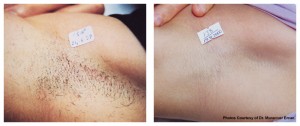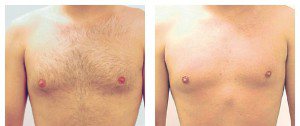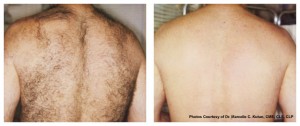Laser Hair Removal
The use of laser energy for hair removal has now become routine. Because of the efficiency and long-lasting results associated with laser hair removal, it is often considered a more desirable option in comparison to shaving, waxing, and other hair removal techniques. At Weston Plastic Surgery, laser hair removal has become one of our most popular cosmetic procedures. Laser hair removal can effectively and safely reduce the presence of unwanted hair from almost any area of the body and face. Common treatment areas include the face, upper lip, chest, back, arms, legs, and bikini line.
Our plastic surgeon, Robert Rothfield, MD, and his team use the latest laser hair removal technology—employing both Nd:Yag and Alexandrite lasers depending upon the patient’s skin type— to achieve optimal hair reduction results. During treatment, laser light energy is directed to the melanin in the hair shaft. The energy is absorbed by the hair follicle (leaving the surrounding tissue unharmed), which disrupts the follicle and ideally prevents it from ever regrowing hair. Best of all, the laser can reach many hair follicles at once, enhancing the speed of treatment when compared to other methods like electrolysis (which treats one follicle at a time).
Hair follicles can be in one of three growth cycles, and the growth cycle of each follicle will determine how much hair is reduced during treatment. The laser only affects hairs that are in the active growth phase, so patients typically require several treatments in a series to achieve optimal hair reduction. The best time to repeat treatment is when hair regrowth is taking place; however, it is important to note that this process is different for various areas of the body. Regrowth usually takes one to two months in the face, armpit, and bikini areas—and about two to three months for the back and legs. While our laser hair removal systems are effective for all skin and hair types, patients with dark hair and light skin usually see better results than patients who have red, grey, or blond hair and darker skin tones.
Before undergoing laser hair removal, patients should follow a few simple guidelines to enhance the effectiveness of treatment and minimize potential risks:
- Avoid sun exposure and begin treatment without a tan (real or artificial).
- Do not remove hair in the treatment area via waxing, plucking, or electrolysis prior to laser treatment (for at least 6 weeks).
- Patients with a diagnosis of herpes (simplex 1 or 2) must start a prescribed oral antiviral medication on the day prior to the laser treatment. Medication helps prevent reactivation of the herpes virus.
- Patients taking Accutane® treatment for acne should stop this medication at least six months before treatment.
Following the laser treatment, swelling and redness is expected. The sunburned feeling and swelling usually lasts for one to three hours. The application of ice can provide relief and will also work to reduce any swelling. The redness following the laser can persist for several days and can easily be covered by makeup. Occasionally, several days after treatment it may appear as though the hair is regrowing. The hair is not regrowing. These are actually carbonized hair casts of the hair follicle that has been treated. These casts will be shed without any treatment or can easily be pulled out with tweezers.
Laser Hair Removal Results

Chest

Back
